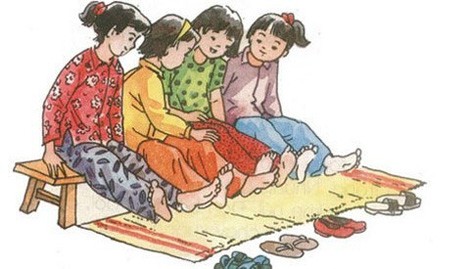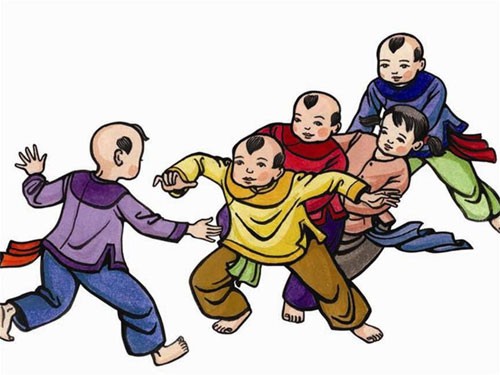(VOVworld) - Đồng dao – children’s folk songs – are simple folk verses created long ago by unknown authors and passed orally from generation to generation. The lyrics are plain, often incoherent or illogical verses, which are rhymed to make them easy to sing and remember. Children sing the songs, which vividly and creatively describe familiar images and relations around them, while playing group games. VOV’s Sunday show looks at children’s folk songs and games in modern society.
The children are singing and playing Chi chi chanh chanh. A child spreads his hand and his or her friends poke their fingers at it while singing together. At the end of the song, the child quickly closes his hand on the last word of the song, trying to catch the slowest finger.
In a Dong dao, the lyrics are independent phrases which are combined randomly in meaning but are consistent in rhythm. Almost every image or fact is symbolic or exaggerated to match the children’s innocent imaginations.
What does Chi chi chanh chanh mean? The children don’t want to know. The song and the associated game make them ecstatic and that’s enough. It will be forever imprinted on their childhood memory. Many Dong dao songs and games teach the children quick reaction, counting, and team work. In Nu na nu nong, the children sit in an orderly fashion side by side and count their legs, one for every word of the song. When the last word of the song falls on a child’s leg, she has to quickly bend that leg before it’s tapped by the singer or she loses the game. In “follow-my-leader”, the children sing together, attentively listening to the commands of the leader, and holding onto the shirt of the next person while moving quickly to avoid breaking the line.
 |
Dong dao songs are in 3 and 4-word or 5 and 6-word verses. The rhyme falls on the last syllable of the verse. This simple style of folk poetry makes the songs easy to remember. Many familiar items, pets, and natural phenomena are personified in Dong dao songs. For example, in “Dung dang dung de” goats go to school, the chicken digs in the kitchen, frogs stay at home, and the God of thunder roars loudly and spreads his lightning hair. These are the first lessons of language, imagination, and perception of his surroundings.
 |
Today, children have less exposure to and interest in folk games because of the proliferation of electronic toys and computer games. Nguyen Thanh Mai, the mother of a 6-year-old-boy, shares her view: "The entertainment space for children is smaller now. In the past, children had more contact with each other when they played in the small lanes or visited each other’s house. One child sang a Dong dao, and others learned it quickly as they played together. Now, families live more independently and the children have less contact with their neighbors."
Master of Pedagogics and poetry Thuy Anh says Dong dao make people look, laugh, imagine, dream, and think. When older people teach little ones folk songs, it creates a generational connection and sharing. Thuy Anh says: "When we were small, we sang and played Dong dao every day. We could run out and play in the street without being afraid of vehicles. We didn’t have toys like Lego or electronic games. Many children now don’t know a Dong dao song or folk game. Dong dao can promote thinking and imagination."
The children learn naturally and joyfully about family bonds, love of nature, the homeland, and work through the simple rhythmic language of Dong dao songs. Although many publishing houses have introduced Dong dao song books, Dong dao needs a community in which to thrive. Writer Nha Thuyen says: "Dong dao is rarely seen in modern life. Apparently, when society develops, the entertainment space for children, particularly in urban areas, shrinks. Dong dao, which is a kind of folk performance, has lost its environment."
At nursery schools, children are taught some Dong dao songs and they can play with their friends. Nguyen Thanh Mai shares her ideas for promoting Dong dao in the family. "We should have clubs of Dong dao supporters. Singing and playing Dong dao tightens bonds between parents and children. Elderly grandparents should teach their grandchildren Dong dao while sharing their memories and thoughts."
Nguyễn Thụy Anh says unborn children react when they hear exterior sounds like language and music. Pregnant mothers should sing Dong dao to lull their children and communicate with them. Playing Dong dao songs together can stimulate small children’s language and communication ability as it encourages them to think and react quickly. Writer Nha Thuyen offers some tips for parents to make Dong dao more familiar. "We can simplify it as a game of language. Parents can set simple and popular topics such as food, study tools and subjects. Then the parents and children take turns making short sentences which match each other in rhythm. Sometime, adults find it difficult because they tend to think of complicated things, but a child’s imagination is more diverse and natural than that of her parents."
Thuy Anh suggests while singing and playing Dong dao, the adults try to think with a childlike mind to be equal with the children. They must engage with the child’s world of melody, image, and language. The adults should not apply their mature thinking but accept the children’s natural growth.